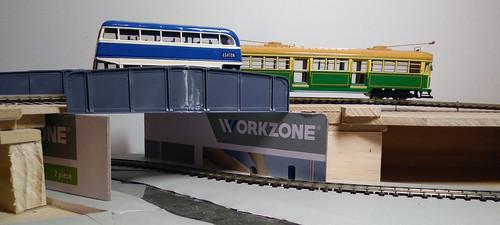Following up from the previous post, the double-decker bus faces the same problem in Wombat Creek as in Melbourne with hitting the awning along the Myer department store. Hopefully the driver pays attention. The photo also shows how well the bus and tram match the colour scheme.
Bus issues
Text & photos from Wombat Creek Tramways Posted on Sun, October 30, 2022 12:13:01- Comments(0) https://wct.payne-ellef.dk/?p=533
- Share
Bus on a bridge
Text & photos from Wombat Creek Tramways Posted on Sun, October 30, 2022 12:06:49In 1938 the board of the tramways in Melbourne decided to replace the cable trams in Bourke Street with double deck buses. Leyland was successful in winning tender for 45 bus chassis and one double deck body. The remaining 44 bodies were built by firms in Melbourne and Adelaide.
The double deck buses were numbered from 201 to 245 in the M&MTB fleet. They were painted in the standard tramway green livery, with numbering and lettering in gold leaf. The buses entered service in October 1940.
By August 1943 it was clear that the conversion of the Bourke Street routes to bus operation had been a failure, for a few reasons:
The Leyland buses required the same two-man crew (driver and conductor) as trams, but could not carry as many people.
Melbourne commuters were unwilling to travel on the top decks of the double deck buses, due to the difficulty of ascending and descending the stairway, particularly as most passenger journeys were relatively short. As a result, the lower deck was overcrowded.
The top decks of the double deck buses frequently collided with shop verandas and electric light poles.
Worn out before they were ultimately replaced by trams, the Leyland double deck buses were all withdrawn by January 1954. The buses were all sold off. Their new owners mostly used the buses as sheds or extra accommodation at holiday homes, but one bus had a unique fate.
It was bought by Wombat Creek Tramways. After a major overhaul including re-painting the bus was put into service at route 9 between Wombat Creek and Gumnut Gully.
Well, most of the above is true. The text is an extract from an article at Melbourne Tram Museum’s website. Only the fate of one bus is not quite true. The bus is a purchase from a well-known website. The price and colours were right for Wombat Creek Tramways. Only the side logo, destination box and number plates have to be altered.
- Comments(0) https://wct.payne-ellef.dk/?p=529
- Share



